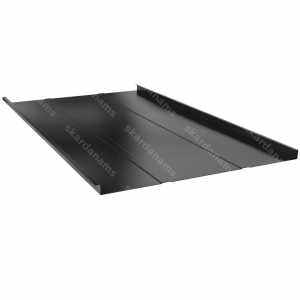Technical information
Useful width – 550 mm
Thickness – 0,45 – 0,65 mm
Length – 100 – 8000 mm
The minimum roof inclination – 5°
We offer two types of sheet metal roofing panels. One with the smooth finishing surface. The other has two strengthening ribs.
Installation
Sheet metal panels can be laid on the wooden planks. Timber materials should be dry and covered with antiseptic agent. The preferred dimensions of the planks are 22 x 100 or 25 x 100 mm. The planks should be calibrated. The distance between the plank of the roof board depends on the angle of inclination of the roof and the distance between the rafters which is usually between 20 and 60 mm. Planks are fastened to the rafters with two screws and zinc nails.
In addition planks are required for the roof eaves, ridges and valley parts, around the chimneys and roof hatches for snow barriers and other roofing protection elements. Beneath the planks an antioxidant film should be installed.
To fasten roofing panels 0,5 mm thick metal brackets are used or 20 x 60 mm metal strips produced from sheet metal panel cut out leftovers. Brackets are fastened to the planks with zinc screws or nails. The amount of brackets depends on the building location and height. The maximum speed of the wind should be taken into account as well. The minimal bracket amount in the central part of the roof is 4 items per 1 square meter and 5 items per 1 square meter closer to the roof edges and eaves. As a result the recommended distance (step) between brackets is 350 – 450 mm. Mastic should be applied in the place of seam areas.
Roofing panels can be fastened to each ocher with the help of mallet or for faster result with the help of special roof rolling tool.
The minimal required plank array close to the valleys is 500 mm for both sides and 1000 mm close to the stovepipes for both sides.
Maintenance requirements
Water and soft brush are usually used to clean the dirt from the roof. If the surface is very dirty, cleaning soap can be used as a detergent for painted surfaces. After the use of the funds, the surface should be thoroughly rinsed with clean water.
The steeper the roof is, the shorter the snow remains on its color coated surface without providing additional load on the overall roofing constructions. If the roof has a slight slope, the snow sticks to it, as a result it should be cleaned off the roof for safety reasons. Before cleaning the snow from the roof the instruments should carefully selected. They should not scratch or distort the surface of the panels.
Warranty
SIA SKĀRDA NAMS warranty period depends on the sheet metal coating type. Please refer to the list below:
POL (polyester) – 5 years
PUR MAT (matte pural) – 10 years
PUR (pural) – 15 years
The warranty is active from the date of purchase.
Warranty terms
The guarantee applies to the roof and walls with a polymer-covering, which is maintained under normal environmental conditions. The warranty covers the following damage types which may be a result of special climatic conditions:
– coating color secession;
– surface cracks;
– uneven or excessive color tone change.
Warranty is valid, if:
1. Roof and wall materials are installed in accordance with assembly instructions, for example, free water runoff is ensured from the surface of the product;
2. Appropriate screws with the sealing rubber are used for material strengthening;
3. SIA Skarda Nams material storage and maintenance terms are complied;
4. Building object is located at the territory of the Republic of Latvia.
Warranty is void, if:
1. The coating is damaged due to extreme climatic conditions, e.g. an increased amount of chemical reagents (gas, vapour, liquid, salts) or dust in the air;
2. The coating is damaged by the fire, explosion, storm, earthquake, radiation, lightning, hail, floods or other environmental disasters;
3. The coating is damaged as a result of abusive interaction or wartime conditions;
4. The coating is damaged due to improper construction or installation;
5. The material was cut by an abrasive disc;
6. The coating is mechanically damaged, during assembly, transportation or improper storage;
7. The brightness of the coating changed;
8. Paint tone changed evenly;
9. Paint tone changed due to dirt on the surface of the material, or the so-called carboxylic efflorescence;
10. The warranty does not apply to the places where sheets are cut;
11. The buyer cannot provide the bill or invoice.

